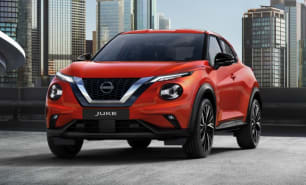Cupra prides itself as a builder of sporty, stylish and offbeat vehicles, and insists that the Tavascan is no exception.
With its design, interior presentation and powertrain supporting such expectations, the acid test is now how the Tavascan performs out on the road.
The really encouraging news is that, on our launch drive experience at least, Cupra’s coupe SUV serves up sportiness and a whole lot more besides.
Let’s start with performance.
Aided by a fine driving position, the Tavascan almost goes out of its way to normalise the EV operating experience, with the now-familiar VW Group column-mounted gear selector being reassuringly straight forward. You’re not left wondering if this thing is even on.
Choose the default Comfort drive setting, and the Cupra whooshes forward with eager yet measured forcefulness, so you’re spared unpleasant jerkiness. Speed builds up quickly and smoothly as the road opens up ahead. So far, so good.
Need extra muscle for overtaking or joining freeway traffic? There’s ample in reserve, revealing the real-world pace and response that even the least-expensive Tavascan offers. The Endurance is a deceptively brisk machine for the money. And that’s before the sportier driving modes are engaged.
Speaking of which, the steering is simply superb, offering sharp yet progressive cornering capabilities. You feel connected to the car, and that translates into very predictable handling and reassuring roadholding. Cupra is starting to shape up as one of our favourite non-German German-owned brands.
But the biggest shock is the Tavascan’s ride quality.
Now, though wearing 19-inch wheels and on steel springs, Cupra’s sporty leanings meant we expected the base grade to ride with tolerable firmness at best.
Instead, over Adelaide’s suburban streets leading into the hills (and then beyond), the suspension provided a sophisticated blend of suppleness and control, ably dealing with the rough stuff without any real abruptness.
Our only note here is that you can hear the suspension working underneath, in an endearingly old-fashioned mechanical way. Odd, but not to a distracting point.
Plus, while there are three levels of regen-braking assistance, we’d like the option of single-pedal driving capability.
Much the same dynamic flair applies to the Interior Package option that swaps out for 20s, except that the ride is clearly just that little bit firmer. But tyre and road drone do seem to drown out the suspension noise at times, but not to any alarming degree. Just in a typically German-engineered vehicle sort of way. No revelations here.
Switching to the VZ is equally revealing.
As you might expect, the extra power and additional (undisclosed) torque from the front electric motor are immediately obvious, elevating its performance significantly. Point, squirt, shoot. This thing really hustles along.
Yet it is the flagship’s balance and control of the chassis that came as a surprise.
Usually, the additional weight of two motors and 21-inch wheels detract from the driving pleasure of many an EV SUV with their shifting mass and heavier feel, but the VZ seemed to contain those tightly, and instead dishes up speed with agility and finesse.
Better still, the top spec’s standard adaptive dampers also seem to help deliver a supple and isolated ride, soaking up bigger potholes and that sort of thing, in a superior way that – we suspect – even the Endurance on 19s likely could not.
Factor in the beautifully nuanced and thoughtfully-tuned driver-assist tech systems, and – after months of driving at-times infuriating SUVs from China – the Chinese-made Tavascan feels anything but rushed or half-baked.
We’re impressed, at least on this first drive.
Ultimately, even after hours and hours behind the wheel, the Tavascan left us wanting more in a good way, not less. That’s a sure sign that the recipe is fundamentally right.




















.png)





.png)


.png)

.png)

.png)



.png)

.png)
.png)

.png)


.png)




.png)









































.png)





.png)







.png)

















 copy.png)



















.png)























